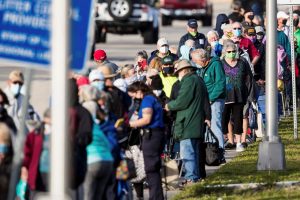The vaccine rollout needs a massive course correction. The federal government needs to take the lead.

- A mass vaccination campaign is never easy, but questionable decision-making at the federal level may have compounded logistical obstacles.
- The federal government must set clear expectations on supply-chain management and establish a clinical workforce to administer the vaccine.
- Biden hopes to administer 100 million doses in his first 100 days — but without educating the public, this will prove difficult.
- Brian L. Harper, M.D., M.P.H., is the Vice President for Equity and Inclusion and Chief Medical Officer at New York Institute of Technology, which has medical school campuses in New York and Arkansas.
- This is an opinion column. The thoughts expressed are those of the author.
- Visit Business Insider's homepage for more stories.
The COVID-19 vaccine rollout is not proceeding quickly enough. As of January 19, healthcare professionals had administered only 12 million shots — even though drug companies have distributed over 31 million doses to pharmacies and hospitals across the United States. Federal officials had originally hoped to vaccinate well over 20 million people by the end of December.
Getting more needles in Americans' arms can mean the difference between life and death, particularly for those at risk. The virus is killing thousands of people each day.
A mass vaccination campaign is never easy, of course. Manufacturing hundreds of millions of vaccine doses is a herculean undertaking. Transporting and storing them presents another hurdle: the Pfizer vaccine, in particular, requires specialized freezers to keep doses at negative 70 degrees Celsius. Even handling and administering these vaccines is a complicated process that requires special training.
But questionable decision-making at the federal level may have compounded these logistical obstacles.
Compounding issues in the vaccine rollout
Federal officials have decided to delegate responsibility for vaccine distribution and administration to individual states, most of which were — and remain — stretched to the breaking point. Resources are scarce. Hospitals are overcrowded. Healthcare professionals are overburdened.
State-level officials sounded the alarm months ago. In mid-October, New York Governor Andrew Cuomo and Arkansas Governor Asa Hutchinson wrote to the president, asking for "additional guidance and clarification … on the roles and expectations of states in a successful COVID-19 vaccine distribution and implementation plan." Unfortunately, federal leaders have not provided adequate advice or support to create an effective strategy.
Although the federal government has poured an impressive $18 billion into developing COVID-19 vaccines, it had, until recently, allocated only $340 million to rollout planning and logistics.
The stimulus bill passed in late December finally provided $8 billion to state vaccination campaigns. However, it would have been much more helpful if lawmakers dispensed that funding months ago, instead of waiting until the FDA had already approved two vaccines for emergency use. Additional resources would've given state and local health authorities the ability to proactively hire more staff and set up additional vaccine delivery sites long before those doses were shipped out.
Shortages of key materials, including the dry ice needed to keep Pfizer's vaccines deep-frozen, have created bottlenecks in the supply chain. And a dearth of federal guidance has forced states to act independently to address logistical challenges — none of which have easy solutions.
The federal government must take the lead
State and local health authorities, not to mention individual clinics and hospitals, will have major difficulty overcoming these obstacles alone. The federal government must take the lead by setting clear expectations on supply-chain management and providing financial support to train and establish a clinical workforce to directly administer the vaccine. Resources should also be allocated to state and local health departments to monitor and keep track of those vaccinated.
It would also be wise for officials to consider a more flexible strategy regarding the exact order in which patients receive vaccines.
Of course, it's only logical that the most vulnerable groups and the healthcare safety net be prioritized. But strict adherence to the priority list should not lead to wastage of the vaccine. Pfizer's vaccine only lasts five days stored at regular temperatures.
Mechanisms and procedures should be developed such that if a dose can't be administered to a prioritized individual in a timely fashion, it needs to go to someone else — regardless of their age, occupation, or health status — to avoid the disposal of the vaccine. Inoculating as many people as possible, as quickly as possible, means giving providers on the ground more flexibility in administering the vaccines. Concurrently, regulations should also be established to penalize those who purposefully attempt to ignore prioritization guidelines.
Fortunately, President Biden hopes to immediately address the obstacles that have slowed the vaccine rollout. Last Friday, he announced plans to establish more vaccination sites, increase the distribution and supply of vaccines, open up eligibility to more Americans, and hire more public health workers who can administer shots.
That's a promising step — but meeting his administration's goal of 100 million doses administered in the first 100 days will still be a massive uphill battle. The push to increase supply may also result in additional manufacturing challenges.
Plus, there are still many Americans who aren't sure whether they'll get the vaccine — even if it's made available to them.
That's why educating the public about the value and safety of COVID-19 vaccines is similarly essential. Many Americans, particularly those in minority communities, harbor serious doubts about these vaccines. As I found during my time working with patients during the height of the HIV/AIDS crisis, building trust in these communities requires concerted, on-the-ground outreach efforts that are far more extensive than what we've seen so far.
A national vaccination campaign was always going to be demanding. But given the record-breaking spread of the coronavirus, the pace of the current effort must be rapidly improved if lives are to be saved. A massive course correction is urgently needed.
Read more:
Source: Read Full Article
